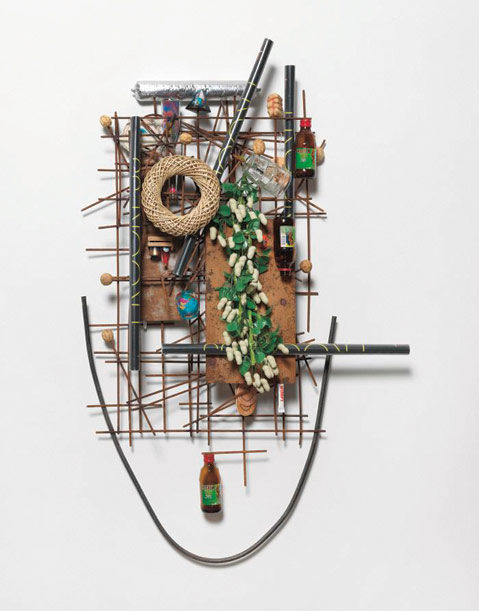Hamza Walker, the curator behind Teen Paranormal Romance, the nationally touring group exhibition that just opened at MCA Santa Barbara, describes the show’s title as “found poetry.” “I was in Chicago, looking for a book that my daughter asked me to buy — one of the novels in the Divergent series,” Walker told me, “and it was sold out everywhere, so I wound up in front of this massive section full of YA novels at Barnes & Noble, and when I looked above the shelves, there was this label, ‘Teen Paranormal Romance.’ It started me thinking.”

Walker, who will co-curate the 2016 Made in L.A. exhibition at UCLA’s Hammer Museum, thinks a lot, not only about contemporary art but also with it. Choosing work, interpreting it, and even hanging it at precisely the right height in the gallery — these activities all manifest the freewheeling Walker’s nonstop thought process. The shows he curates, like his conversations, bubble, pop, and fizz with ideas, associations, and insights.
So what did this particular snippet of found poetry — Teen Paranormal Romance — start Walker thinking about? “How much intensification goes on in this popular young adult genre,” for one thing, and “why young people today love to read about characters who have animal selves, and who become werewolves or vampires.” Why did he decide to create the exhibit? In “Spells Like Teen Spirit,” his introductory essay to the show, Walker writes that “the intensification of adolescent drives is perfectly suited to serve as a crystalline cipher” for a wide range of contemporary ideological positions.
This exhibition, which is made up of works by high-profile professional artists with international reputations, aims to resuscitate surrealism’s connection to the unconscious “in the wake of a YA-driven media zeitgeist.” Given this ambitiously intellectual statement of purpose, it’s a pleasure to report that the art works on many visceral levels, regardless of one’s ideological position or attitude toward the unconscious.
Three very large sculptures dominate the main room. I’ll engage them in order of size — from large to enormous. Jack Lavender has several assemblage works in the show, all of them constructed out of a combination of industrial building materials and household detritus. “Fantasy Line” from 2013 is a 15-foot, vertically oriented diagonal slash of steel surmounted with an empty cardboard box. There’s the memory of playground equipment present here — perhaps the base for a portable basketball hoop — but there’s also a sly art-historical reference to Richard Serra’s seminal “prop” series of sculptures, icons of 1960s minimalist abstraction. In tandem with Lavender’s other work, and in the context of the rest of the show, what “Fantasy Line” lodges in the mind is an enigmatic sense of fundamental disconnection.
Nearby stands another, even larger sculptural object by Anna K.E., “Lucky Weekend,” that’s also both puzzling and self-supporting. One side is taken up by a 20-foot patch of basic white tile, embellished in the main by a simple and colorful abstract design, and further occluded by an ever-growing stack of works on paper that are glued on top of one another. It’s a bit like abandoned amateur subway art. The reverse side reveals the wooden trestles that support the tile surface, along with a half-dozen clothes hooks holding bright, cheap looking garments. “Lucky Weekend” is more than an object, but not quite a place. This eerie liminal status pulls the viewer in, yet leaves open the question of where precisely one ends up by engaging it.
The largest work in the show leaves no doubt on that score. “Friends and Lovers,” the 2010 installation by Kathryn Andrews, consists of chain-link fence, concrete blocks, wood, and paint. Although it exists in variable states depending on where it is located, the piece’s defining characteristic remains the same — the chain-link fence encloses and effectively locks up as much as half of the gallery’s floor space. Within this entry-less cage sit two freestanding cinderblock walls, each painted white, and each bearing the grinning abstract face of a cartoon bear. For anyone who ever attended public school, the imagery hits with a powerful immediacy. This is that unnerving place where public space loses its private dimension and becomes simply “the quad” or “the yard,” a sphere in which everyone is vulnerable, and no one is at home.
Smaller works in other media expand the presentation without foreclosing on its significance. Two figure photos, Roe Ethridge’s “Louise with Red Bag” (2011) and Jill Frank’s “Bong (Shawn)” from 2014 take us closest to the exhibit’s ostensible subject by depicting teens in stark, but not entirely unflattering, moments of self-exposure. Ed Atkins’s 2013 video “Even Pricks” offers TPR’s most flamboyant kicks, pairing images of an inflatable thumb with those of a collapsing bed in a format that borrows liberally from exploitation film trailers. The duo GuytonWalker merge highly magnified, tightly cropped images with a sculptural impulse in their series of mattresses that have been screen printed with details of paint cans. Finally, there’s Chris Bradley, the sculptor responsible for “Grease Face #3” and “Grease Face #4.”
These trompe l’oeil confections look exactly like empty pizza boxes stained with greasy olive oil. In reality, they are heavy, elaborately manufactured sculptures in steel, aluminum, and cast bronze, painted to resemble dirty cardboard. Like the rest of Teen Paranormal Romance, these riddling artifacts at once beg to be discarded and refuse to be forgotten.



